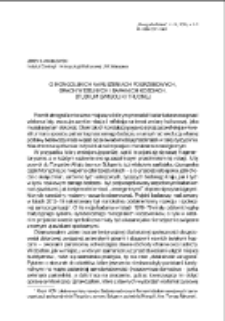- Search in all Repository
- Literature and maps
- Archeology
- Mills database
- Natural sciences
Advanced search
Advanced search
Advanced search
Advanced search
Advanced search

Object
Title: O mongolskich naruszeniach pogrzebowych, grach weselnych i baranich kościach. Studium symboliki trudnej
Subtitle:
Etnografia Polska 59 Z. 1-2 2015 (2016)
Publisher:
Instytut Archeolgoii i Etnologii Polskiej Akademii Nauk
Place of publishing:
Description:
Type of object:
Abstract:
Among the Torghuts of Western Mongolia, some elaborated forms of rituals like wedding and funeral, although discontinued, are still remembered in detail, while their symbolism is forgotten. In the wedding games – being a set of five playful competitions between the bride givers and takers – the process of gradual acquisition of social roles of the bride/wife by the groom’s side is demonstrated, whereas the contested objects (a sheep tibia bone, a carpet, a goat skin etc.) are symbols of her kin group affiliation, her dowry, and her place in the new household, respectively. The games, being a series of mock-refusals and takeovers, with their intrinsic retardations, provide an embodied experience of a gradual passage of the bride, commemorating this event in the social memory
References:
Asad Talal 1996, Modern power and the reconfiguration of religious traditions, Stanford Electronic Humanities Review, vol. 5, issue 1. https://web.stanford.edu/ group/SHR/5-1/text/asad.html
Douglas Mary 1999 [2009], Leviticus as literature, Oxford University Press, Oxford
Kabzińska-Stawarz Iwona 1983, Noworoczne gry mongolskie. Ich symbolika i związki z magią, część I, Etnografia Polska, t. 27, z. 1, s. 253–295
Kabzińska-Stawarz Iwona 1991, Games of Mongolian shepherds, Institute of the History of Material Culture, Warsaw
Kon Feliks 1933, Za 50 let. Èkspediciâ v Sojotiû, Sovetskij Pisatel’, Moskva
Simczenko Jurij 1975, Ludzie Północy, Iskry, Warszawa
Szynkiewicz Sławoj 1981, Rodzina pasterska w Mongolii, Ossolineum, Wrocław
Szynkiewicz Sławoj 1989, On kinship symbolics among the Western Mongols, [w:] Religious and lay symbolism in the Altaic world and other papers, red. K. Sagaster, O. Harrassowitz, Wiesbaden, s. 379–385
Szynkiewicz Sławoj 1990 [2005], Sheep bone – a sign of human descent: symbolism of the tibia among the Mongols, [w:] Signifying animals. Human meaning in a natural world, red. R. Willis, Unwin Hyman, London, s. 70–79
Wasilewski Jerzy S. 1978, Symbolika ruchu obrotowego i rytualnej inwersji, Etnografia Polska, t. 22, z. 1, s. 81–108
Wasilewski Jerzy S. 1979, Po śmierci wędrować... Szkic z zakresu etnologii świata znaczeń, Teksty, nr 8/3 (45), s. 97–120
Wasilewski Jerzy S. 2010, Transgresja wobec tragedii, śmiech przeciwko śmierci. Etnolog w podróży... wirtualnej (7), Konteksty, t. LXIV, nr 4, s. 184–190
Relation:
Volume:
Issue:
Start page:
End page:
Detailed Resource Type:
Format:
Resource Identifier:
oai:rcin.org.pl:61313 ; 0071-1861
Source:
IAiE PAN, call no. P 326 ; IAiE PAN, call no. P 327 ; IAiE PAN, call no. P 325 ; click here to follow the link
Language:
Rights:
Terms of use:
Copyright-protected material. May be used within the limits of statutory user freedoms
Digitizing institution:
Institute of Archaeology and Ethnology of the Polish Academy of Sciences
Original in:
Library of the Institute of Archaeology and Ethnology of the Polish Academy of Sciences
Access:
Object collections:
- Digital Repository of Scientific Institutes > Partners' collections > Institute of Archeology and Ethnology PAS > Institute Publications
- Digital Repository of Scientific Institutes > Partners' collections > Institute of Archeology and Ethnology PAS > Institute Publications > Current Journals
- Digital Repository of Scientific Institutes > Literature > Journals/Articles
- Digital Repository of Scientific Institutes > Partners' collections > Institute of Archeology and Ethnology PAS > Institute Publications > Current Journals > Etnografia Polska
Last modified:
Feb 2, 2022
In our library since:
Dec 23, 2016
Number of object content downloads / hits:
701
All available object's versions:
https://rcin.org.pl./publication/80481
Show description in RDF format:
Show description in RDFa format:
Show description in OAI-PMH format:
Objects Similar
Kozłowski, Janusz Krzysztof (1936– )
Tangad, Oyungerel
Haslund-Christensen, Henning (1896–1948) Hedin, Sven Anders (1865–1952) Boor, Helmut Anton Wilhelm de (1891–1976) Insel-Verlag.
Nowicka, Ewa Zhanaev, Ayur
Jaruga-Nowacka, Izabela (1950–2010)
Glazik, Ryszard (1943– )

 INSTYTUT ARCHEOLOGII I ETNOLOGII POLSKIEJ AKADEMII NAUK
INSTYTUT ARCHEOLOGII I ETNOLOGII POLSKIEJ AKADEMII NAUK
 INSTYTUT BADAŃ LITERACKICH POLSKIEJ AKADEMII NAUK
INSTYTUT BADAŃ LITERACKICH POLSKIEJ AKADEMII NAUK
 INSTYTUT BADAWCZY LEŚNICTWA
INSTYTUT BADAWCZY LEŚNICTWA
 INSTYTUT BIOLOGII DOŚWIADCZALNEJ IM. MARCELEGO NENCKIEGO POLSKIEJ AKADEMII NAUK
INSTYTUT BIOLOGII DOŚWIADCZALNEJ IM. MARCELEGO NENCKIEGO POLSKIEJ AKADEMII NAUK
 INSTYTUT BIOLOGII SSAKÓW POLSKIEJ AKADEMII NAUK
INSTYTUT BIOLOGII SSAKÓW POLSKIEJ AKADEMII NAUK
 INSTYTUT CHEMII FIZYCZNEJ PAN
INSTYTUT CHEMII FIZYCZNEJ PAN
 INSTYTUT CHEMII ORGANICZNEJ PAN
INSTYTUT CHEMII ORGANICZNEJ PAN
 INSTYTUT FILOZOFII I SOCJOLOGII PAN
INSTYTUT FILOZOFII I SOCJOLOGII PAN
 INSTYTUT GEOGRAFII I PRZESTRZENNEGO ZAGOSPODAROWANIA PAN
INSTYTUT GEOGRAFII I PRZESTRZENNEGO ZAGOSPODAROWANIA PAN
 INSTYTUT HISTORII im. TADEUSZA MANTEUFFLA POLSKIEJ AKADEMII NAUK
INSTYTUT HISTORII im. TADEUSZA MANTEUFFLA POLSKIEJ AKADEMII NAUK
 INSTYTUT JĘZYKA POLSKIEGO POLSKIEJ AKADEMII NAUK
INSTYTUT JĘZYKA POLSKIEGO POLSKIEJ AKADEMII NAUK
 INSTYTUT MATEMATYCZNY PAN
INSTYTUT MATEMATYCZNY PAN
 INSTYTUT MEDYCYNY DOŚWIADCZALNEJ I KLINICZNEJ IM.MIROSŁAWA MOSSAKOWSKIEGO POLSKIEJ AKADEMII NAUK
INSTYTUT MEDYCYNY DOŚWIADCZALNEJ I KLINICZNEJ IM.MIROSŁAWA MOSSAKOWSKIEGO POLSKIEJ AKADEMII NAUK
 INSTYTUT PODSTAWOWYCH PROBLEMÓW TECHNIKI PAN
INSTYTUT PODSTAWOWYCH PROBLEMÓW TECHNIKI PAN
 INSTYTUT SLAWISTYKI PAN
INSTYTUT SLAWISTYKI PAN
 SIEĆ BADAWCZA ŁUKASIEWICZ - INSTYTUT TECHNOLOGII MATERIAŁÓW ELEKTRONICZNYCH
SIEĆ BADAWCZA ŁUKASIEWICZ - INSTYTUT TECHNOLOGII MATERIAŁÓW ELEKTRONICZNYCH
 MUZEUM I INSTYTUT ZOOLOGII POLSKIEJ AKADEMII NAUK
MUZEUM I INSTYTUT ZOOLOGII POLSKIEJ AKADEMII NAUK
 INSTYTUT BADAŃ SYSTEMOWYCH PAN
INSTYTUT BADAŃ SYSTEMOWYCH PAN
 INSTYTUT BOTANIKI IM. WŁADYSŁAWA SZAFERA POLSKIEJ AKADEMII NAUK
INSTYTUT BOTANIKI IM. WŁADYSŁAWA SZAFERA POLSKIEJ AKADEMII NAUK


































